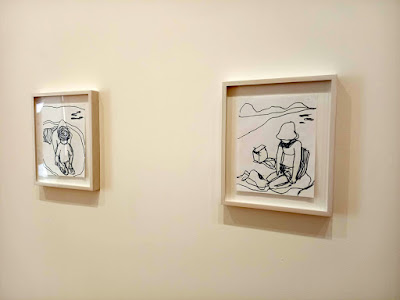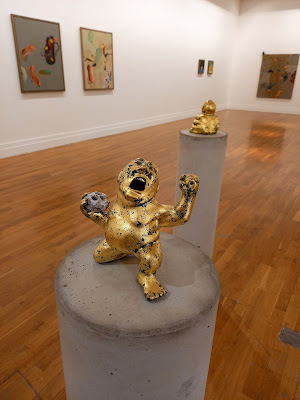In a further exploration of reopening places, I visited the gorgeous Rathfarnham Castle a few weeks ago in order to see the annual selected members of Ceramics Ireland group exhibition. As with other larger indoor public spaces (Rathfarnham Castle is managed by the OPW) I booked my viewing time and had a leisurely stroll through the exhibition.
Musings about art, writing, music, travel and food (life, the universe & everything...) by Lorraine Whelan
Wednesday, 30 June 2021
Ceramics Ireland 2021 exhibition
Wednesday, 23 June 2021
Dublin gallery day - part 3 of 3
More than two weeks have passed since I made my big excursion in to Dublin for a "gallery day", but it was impossible to blog about it all in one blog day, so I divided up chronologically to suit how my day went. I blogged about the first two stops (The Molesworth Gallery and The National Gallery) last week, and you can find that blog here and I continued on to see Damien Flood's new exhibition, Tilt, at the RHA, which I blogged about here. The RHA is so huge that there was another big exhibition going on across the hall: Sean Scully's "Eleuthera", recent paintings titled after the Caribbean island where his family holidayed a few years ago.
Wednesday, 16 June 2021
Dublin gallery day - part 2 of 3
It seems ages away now, but it was less than two weeks ago that I had my big excursion in to Dublin for a "gallery day". I blogged about the first two stops (The Molesworth Gallery and The National Gallery) last week, and you can find that blog here. But the catalyst that got me venturing into Dublin in the first place was desire to see Damien Flood's new exhibition, Tilt, at the RHA. I met Flood (always Damo to me) many years ago when he was a teenager and a friend to several of my nieces. For many years now, he has been quite an accomplished artist and I am always curious to see the development of his work. I was aware of his (relatively) new excursion into ceramic figurative work and wondered how it would fare in juxtaposition with his paintings.
Wednesday, 9 June 2021
Dublin gallery day - part 1 of 3
During lockdown this year, I have been enjoying Graphic Studio Dublin's series of artist zoom presentations, Artists Beyond the Studio. A few weeks ago the final presentation was made by Cian McLoughlin, sixteenth in the series, in advance of lockdown being gradually eased and cultural venues reopening. Though he has done printmaking, McLoughlin is primarily a painter and his presentation and work shown was amazing; a recording of his presentation can be seen here, and many of the other artist talks are on GSD's youtube channel. In talking about his newest work McLoughlin made me aware of his upcoming exhibition at The Molesworth Gallery in Dublin, and this is where I started my "gallery day" in Dublin last week.
The Molesworth Gallery is a private gallery in a refurbished Georgian building, not far from The National Gallery and the RHA Gallery, which were on my list for exhibition-viewing that day. Unlike the two larger galleries, The Molesworth did not require advance booking of free entry tickets (I enquired to be sure), so after parking the car a short walk took me to the gallery.
Wednesday, 2 June 2021
carnage for foragers!
A couple of weeks ago I heard this loud squawking from a large number of birds. I was indoors, but the sound was cacophonous and I wondered what was going on. On my morning walk I saw that workmen from the Council were on the edge of the estate with some power tools. I thought they were just planning to do the usual trim, which in itself was always an expected disappointment - they had a habit of annually cutting back the blackberry bushes just as the berries were near to ripening. I had grown accustomed to not foraging for blackberries in my own neighbourhood. Usually, however, that culling was done later in the season,. All this bird protest was probably in a justified panic as I imagine nests were being destroyed.
I could never really see the point of trimming the blackberries either: the bushes were on a small green in the neighbourhood which was used for no purpose other than as an entranceway to the park and as an area for a Hallowe'en bonfire. That wilful destruction of bird habitat was taking place was disturbing to say the least.
Then earlier this week the destruction continued as some bureaucrat with too much time on their hands (covid make-work project?) ordered the cutting down of the elderflower trees in this same area.

































